
examined at Berlin until November or December 1919. The last item definitely examined at Berlin 0 17 was in Februarr 1919 and the first item definitely examined at Berlin W8 was in June 1919. There were two items — one in March and the other in April 1919 - which were probably examined in Berlin. Is there a reason for this?
The small number of items examined in 1923 coming into Germany is explained by the fact that it was decided to stop inspecting such mail in February 1923.
10.2 REASONS FOR SWITCH
One can only speculate on why things happened as they did in 1919. One possible explanation lies in the political situation in Germany and in particular Berlin following the military need at the end of September 1918 to arrange an armistice as soon as possible.
The armed forces became demoralized; the Kaiser fled to Holland; power passed to Soldiers and Workers Councils which sprang up in most places. The Council of the Peoples Commissars, which was nominally in charge until the National Assembly started to work, could not rely on the Army or on the Volkswehr (Peoples Army) organized by the Councils, so demobilized officers were encouraged by the Army high command to recruit reliable volunteers to support the Government and these armed bands were known as the Freikorps.
Strikes were a daily occurrence; the country became very difficult to govern, with rebellions in many places. Except in the province of Posen, these were put down during 1919 by the Freikorps, and usually this was done in brutal fashion.
Berlin saw many strikes and two periods of heavy street fighting, one in January and the other in March 1919. In both cases the Freikorps restored order. It was considered unsafe for the first meeting of the new National Assembly, which opened in Weimar in February 1919 and did not move back to Berlin on a permanent basis until the end of September 1919.
So it is perhaps not surprising that the examination of mail for exchange control purposes in Berlin broke down — perhaps only occurring erratically. Perhaps it was moved from Berlin 0 17 to Berlin W8 because it was safer there. What is perhaps surprising is that the exchange control examinations appeared to have continued without any obvious trouble in both Hamburg and Munchen despite political problems in these two cities.
11. SUMMARY MD ACKNOWLEDGMENTS
The many labels, cachets and wax seals used by the exchange control offices in Berlin 0 17 and Berlin W8 after the first world war have been described and, where possible, illustrated.
Danzig Report Vol. 1 - Nr. 77 - October - November - December - 1992, Page 41.
Hits: 3141
Added: 03/07/2015
Copyright: 2025 Danzig.org

